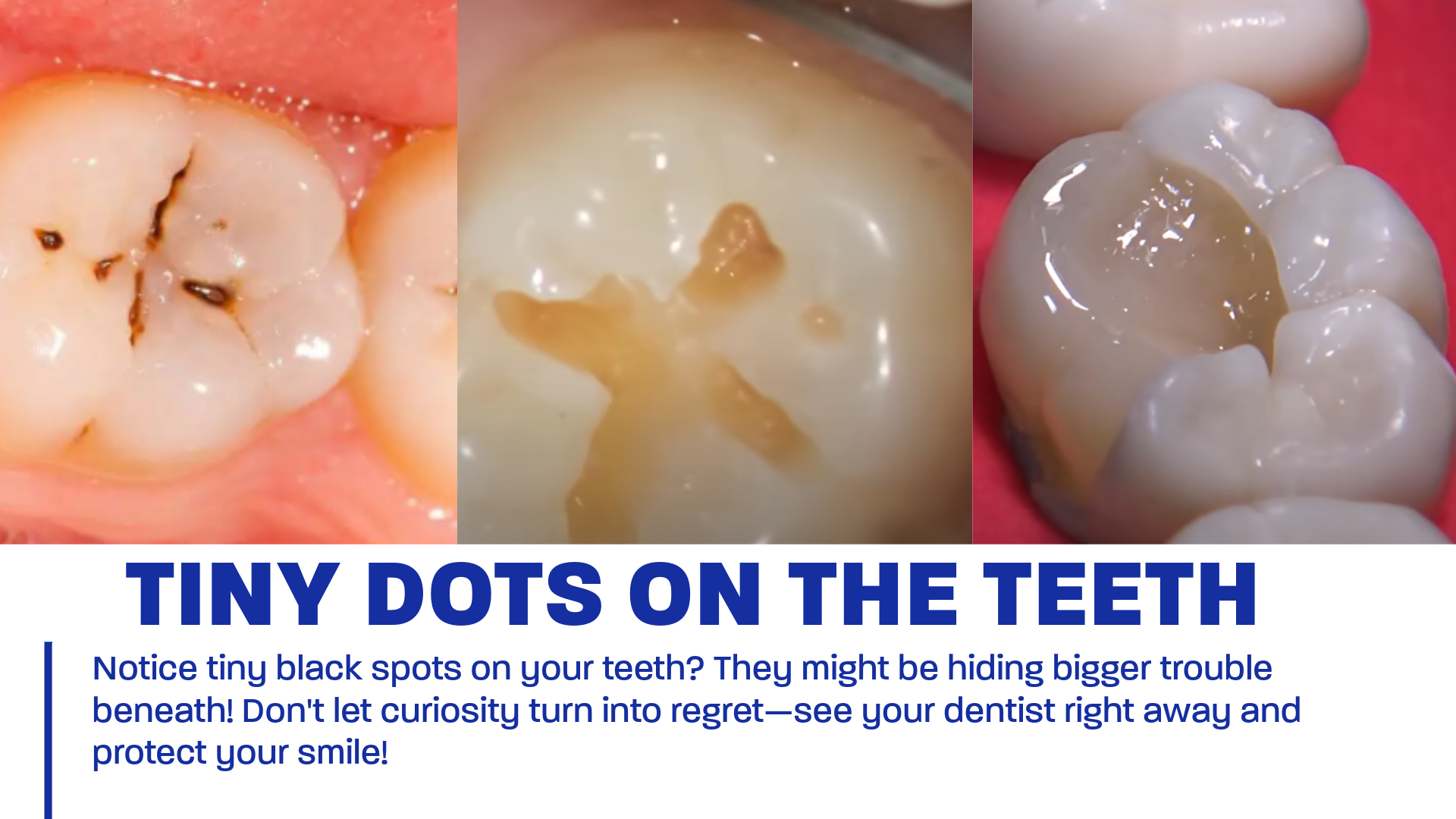
It is quite natural to panic when you notice small black spots or lines suddenly appearing on your teeth. While these tiny spots may appear innocent at times, they can also indicate a deep-rooted cavity. But what are these black spots really a sign of? Is it a simple stain or the initial indication of a more serious issue?
What you may not know is that these little black dots are special and stubborn stains that often never come out with the usual dental care routine but can be removed with the intervention of professional hands. In our article, you will find out the real causes of black spots on teeth, how to effectively diagnose them, and which treatment methods can help you get rid of them for good. If you want to solve the mystery behind blackheads on your teeth and be able to smile easily again, read on!
What is a Black Dot on Tooth?
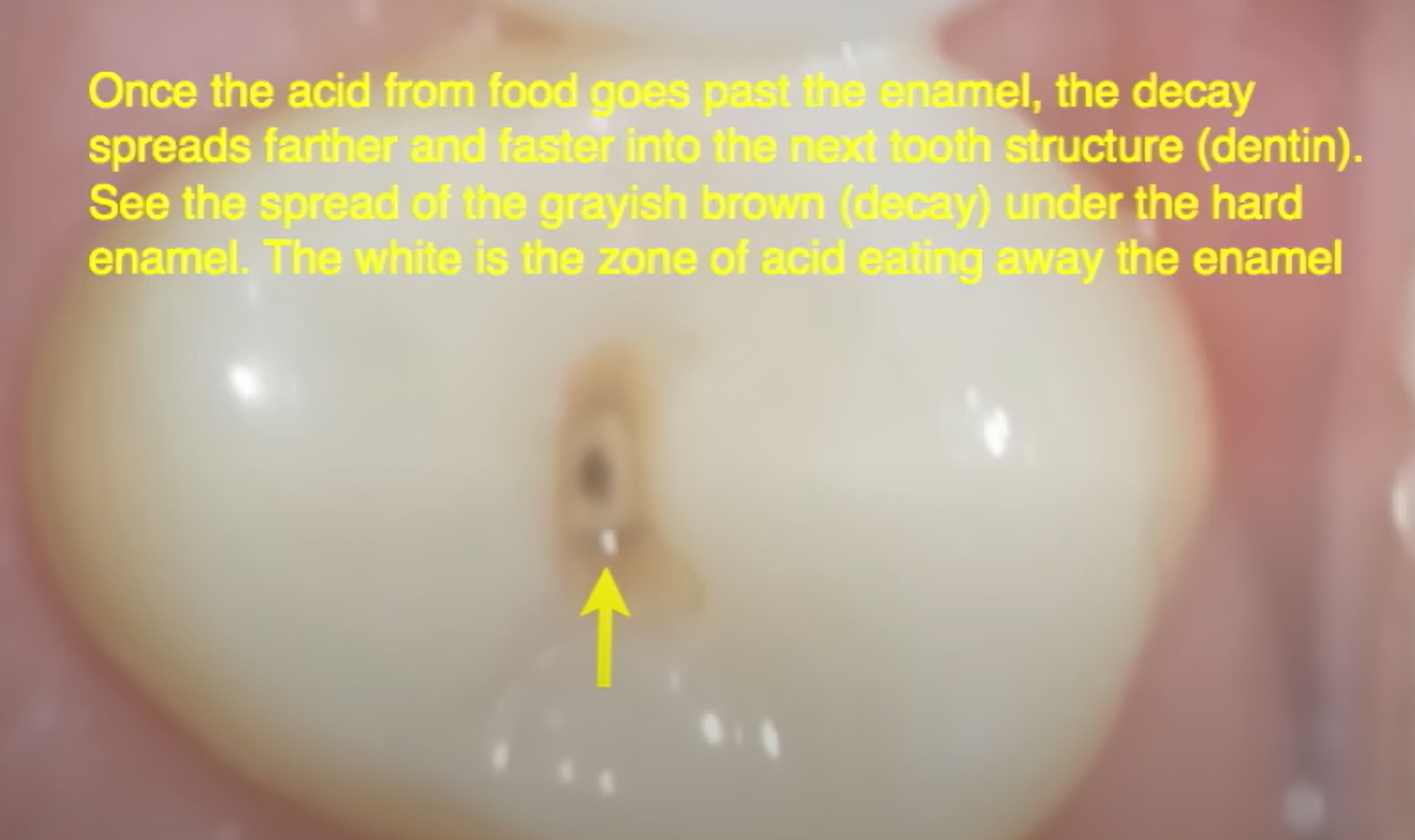
Black dots on teeth are a special type of discoloration, commonly known as "Extrinsic Black Tooth Stain" or EBS for short. This occurs on the outer surface of the teeth and appears as small black dots or dark-colored fine lines, especially in the areas close to the gums, i.e. the cervical triad of the teeth. Occasionally these spots may merge to form longer, dashed lines and may even appear on the recessed and protruding parts of the teeth (pits and fissures).
Unfortunately, EBS stains cannot be removed with routine daily oral care. These stains, which are firmly attached to your teeth, are very difficult to remove with brushing or toothpaste. These stains can only be removed with a professional cleaning procedure (scaling or debridement) by your dentist. However, even after professional cleaning, it is quite common for these stains to reoccur in a short time.
EBS is a special type of plaque that, when examined under a microscope, contains a high concentration of Gram-positive bacilli and cocci. They are also known to contain calcium particles and iron compounds. The metabolism of these bacteria produces black-colored substances or inorganic substances like iron sulfide, which are believed to cause these stains.
How to diagnose EBS;
Different scientists have set various criteria to diagnose EBS. For instance, Koch's criteria (1) say that EBS can be diagnosed if there is a group of dark spots smaller than 0.5 mm on the tooth surfaces that are parallel to the gingival margin on at least two different teeth. Other researchers have presented different classifications according to the amount, continuity, and extent of pigmented plaque.
Although these black spots do not cause any physical discomfort, they can seriously disturb people aesthetically. Especially in children, this is known to cause self-confidence problems. Many people may hesitate to smile or speak because of these black spots on their teeth, which can be socially uncomfortable.
In short, these small black spots on the teeth usually do not pose a health risk, but can be aesthetically striking. Therefore, regular professional cleanings with the help of your dentist will help keep this problem under control.
Common Causes of Black Dots on Tooth
Black spots on the teeth can be a common complaint of many people. Although these spots sometimes seem small and harmless, they actually give important clues about your dental health. So, what are the common causes behind these blackheads?
Dental Caries (Cavities)
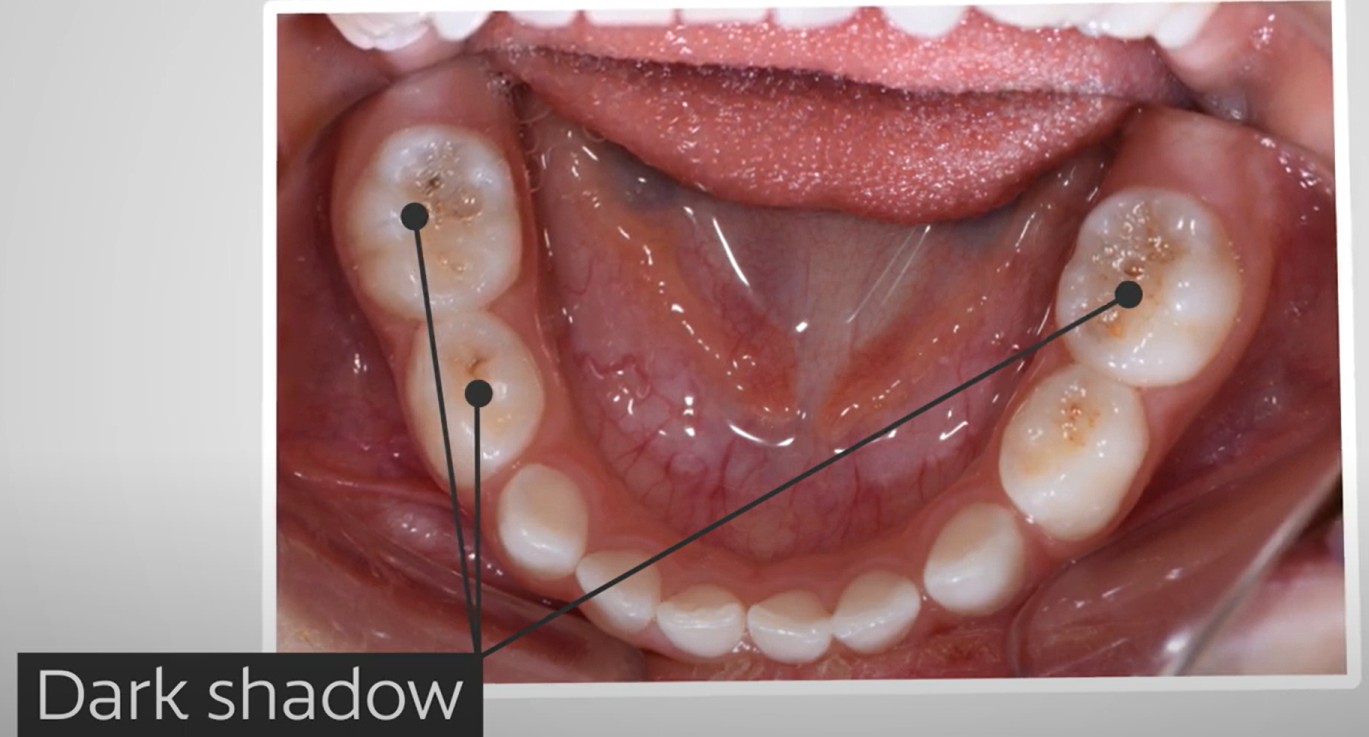
First of all, one of the most common causes of black spots on teeth is tooth decay. Initially, cavities appear as white spots; however, over time, they progress on the tooth surface and cause discoloration. These progressive decays begin to appear as dark shadows or black spots, especially between the teeth or near the gum line. These spots indicate that the decay has progressed and now requires deeper treatment.
Dental Plaque and Tartar
Another common condition is "extrinsic black teeth stains", also known as black plaque. These stains appear as small black dots or lines on the tooth surface or near the gum line. This is caused by the accumulation of certain types of bacteria in the mouth. These bacteria accumulate in dental plaque and combine with calcium to form black stains over time.
Stains from Foods and Beverages
What we eat and drink can also cause black spots on teeth. In particular, tannins found in beverages such as tea, coffee and wine attach to the surface of the teeth and form brown or dark stains. In addition, the compounds in these drinks can interact with iron in the mouth, creating black-toned stains.
Smoking and Tobacco Use
Smoking and tobacco use can cause dark discoloration of the teeth, but usually in shades of brown or yellow. Although not directly linked to blackhead formation, it contributes to the overall darkening of teeth and can make other existing stains more visible.
Dental Trauma
Finally, dental trauma can also cause discoloration, but this is usually related to the internal structure of the tooth. Post-traumatic tooth discoloration may appear in shades of gray, pink or brown, but it does not appear as small black dots on the outer surface.
To summarize; when you see black spots on your teeth, there may be various reasons for this, such as decay, plaque accumulation or your eating habits. You can prevent black spots and protect your oral health with regular teeth cleaning and routine check-ups.
Less Common Causes
There are actually some not so common causes of black spots on the teeth.
Fluorosis
Let's start with a condition called fluorosis. Fluorosis is usually caused by too much fluoride intake in childhood. However, this usually does not cause black spots, but white lines or stains on the teeth. If the condition is more severe, the white spots can turn brown over time and even cause slight roughening of the enamel. So there is no clear information that fluorosis directly causes blackheads.
Medication Side Effects
Let's talk about medicines. Especially antibiotics are known to cause tooth discoloration. The most well-known example is tetracycline group drugs. These can cause internal discoloration of the teeth, but usually these discolorations are in yellow or brown tones, not in the form of black spots. In addition, although antiseptics containing chlorhexidine are also known to cause external stains, we cannot say that they cause blackheads.
Aging and Wear
There is also the aging factor. As we age, the enamel of our teeth wears away and the dentin layer underneath becomes more prominent. This causes the teeth to appear darker in general. However, discoloration caused by aging is usually in the form of a general color tone change. In particular, it is not seen as dotted black spots, but as a general darkening or yellowing.
In short, fluorosis, which is a rare cause of black spots on teeth, usually causes white streaks, antibiotics usually cause yellowish or brownish stains, and aging causes general darkening. The main and most common cause of black spots on teeth is a condition called "extrinsic black teeth stain (EBS)", which is caused by the combination of certain types of bacteria and minerals.
Diagnosing Black Dots on Teeth
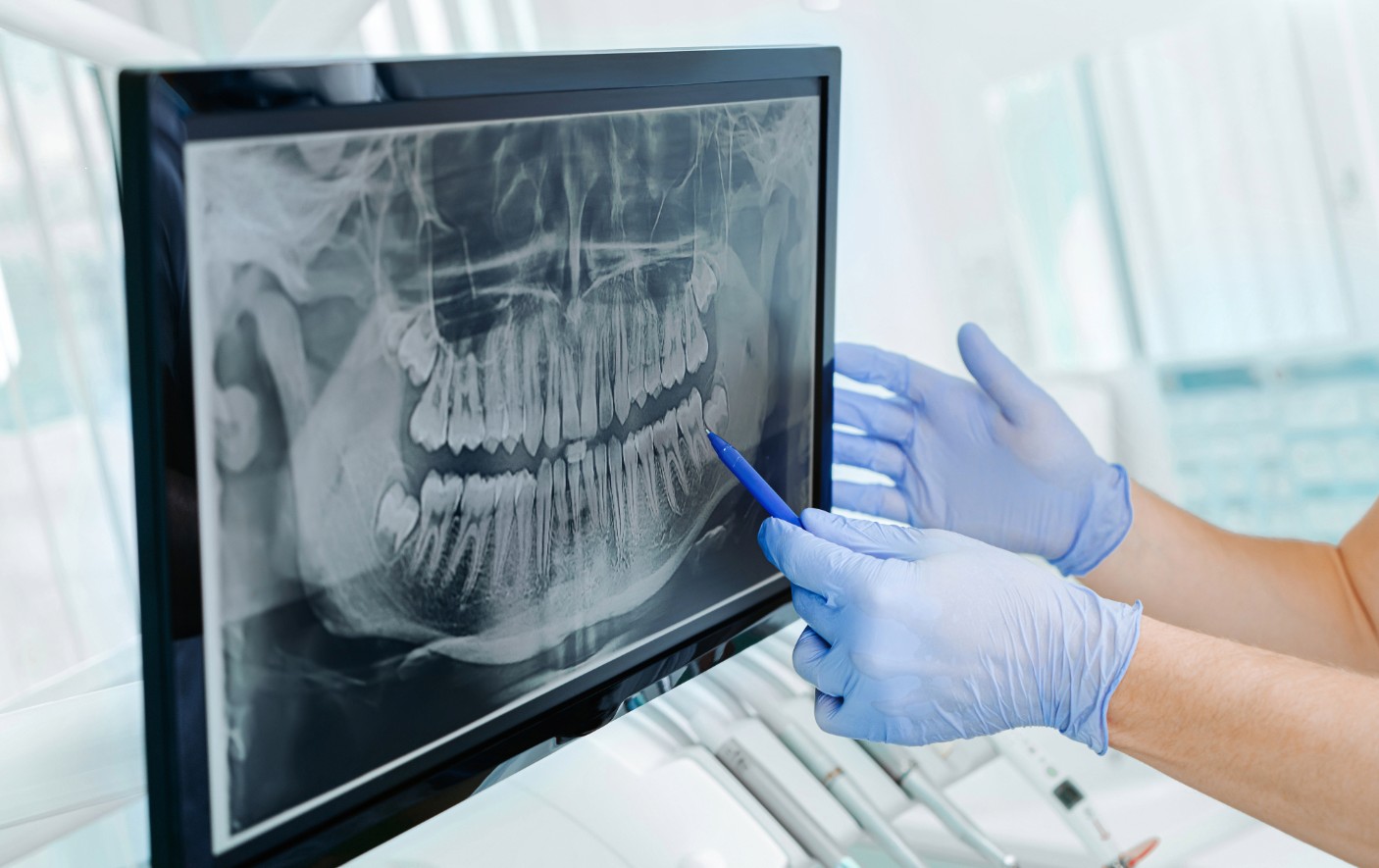
You can visit a professional dentist to understand why black spots appear on the teeth. Because black spots can be caused by different reasons; sometimes it can be a simple surface stain, while sometimes it can be a sign of a serious decay. Therefore, a detailed evaluation by the dentist can reveal the real cause of the problem.
To diagnose black spots, the dentist first performs a detailed visual examination. In this examination, the number, size, color and position of the black spots on the tooth are examined. Particular attention is paid to how close the spots are to the gum line. This is because some black spots appear as small dots or fine lines, especially around the gum line, and this appearance makes them easier to diagnose.
For example, in the case of what we call "extrinsic black teeth stain (EBS)", the black spots are usually in the form of thin dark lines or dotted spots that follow the gum line. Dentists can recognize these types of stains immediately because they have a very distinctive and characteristic appearance.
In some cases, the dentist may also ask for an X-ray to be sure. But here's an important detail: X-rays are not actually used to directly diagnose the black spot. X-rays may be needed to see if there is a cavity underneath the black spots. This is because sometimes black spots may look like a simple stain on the outside, but may actually be a sign of a hidden cavity underneath. X-rays can clearly show the depth and size of these bruises.
Treatment Options for Black Dots on Teeth
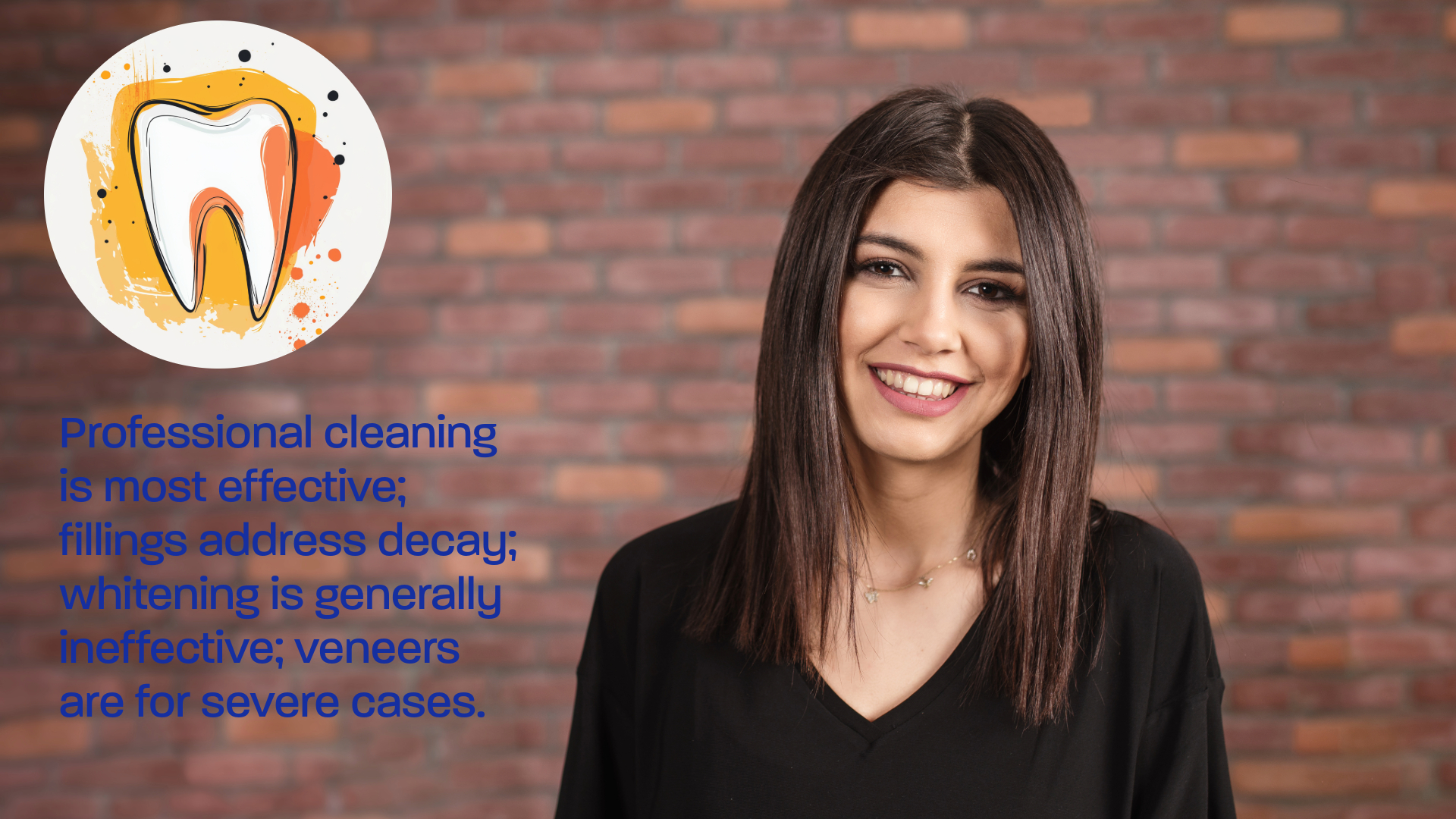
Although black spots on the teeth are usually not a serious problem, they can be visually disturbing. Fortunately, there are several different treatment options:
1. Professional Teeth Cleaning (Scaling and Polishing)
The most common and effective treatment for black spots on teeth is professional teeth cleaning. Unfortunately, daily brushing or flossing at home is not enough to remove such stains. Because these spots are actually a special type of plaque that adheres very tightly to the tooth surface. These stains can be easily cleaned by the dentist using special tools.
The treatment takes about 15-20 minutes and is not painful at all. The dentist first scrapes away the stains and then polishes the teeth with special brushes and pads. Finally, they may apply some creams that strengthen and protect the enamel. However, it should not be forgotten that these stains can reoccur over time, so regular teeth cleaning is essential.
2. Dental Fillings
The use of dental fillings is more related to tooth decay. In other words, if the black spots are actually the beginning of a decay or a symptom of an advanced decay, then the dentist can clean the decay and cover that area with a filling. However, this procedure is generally preferred not for superficial stains, but for situations that damage the tooth structure.
3. Teeth Whitening Procedures
Teeth whitening methods are usually used for general discoloration. It is not clear whether these methods are particularly effective against black spots, which are strongly attached to the surface of the tooth. Since black spots contain complex compounds made up of minerals such as iron or sulphur, whitening agents may not be effective enough against such spots. Therefore, bleaching is not recommended for black spots.
4. Dental Veneers and Crowns (Veneers)
Veneers (laminates) and crowns are usually used for more serious aesthetic problems. Veneers may be considered if black spots are widespread, if professional cleaning has failed to achieve adequate results, or if there is a general need to improve the appearance of the teeth. But it is definitely not the first option for simple and small black spots. These are more often preferred in cases with major aesthetic problems that cannot be solved in other ways.
In conclusion, if you have black spots on your teeth, the best approach is to first seek a solution with a professional dental cleaning. If the spots are caused by decay, a filling is necessary. Bleaching is generally not very effective for black spots and cosmetic procedures such as veneers are only considered in very advanced cases. For the most accurate determination of all these, it is absolutely necessary to consult a dentist.
FAQ
Below you will find frequently asked questions and answers about black spots on teeth.
What does a black dot on my tooth indicate?
The black dot you see on your tooth is most likely what we call "extrinsic black dental stain (EBS)". These stains appear as small dots or thin black lines, especially near the gum line. They are usually caused by a combination of certain bacteria and minerals such as iron. However, sometimes these black spots can also be a sign of early tooth decay. Your dentist will be able to tell you for sure.
Are black dots always cavities?
No, black dots do not always mean cavities. Most of the time, these black spots are stubborn stains that stick to the tooth surface. Interestingly, people with these black spots usually have fewer cavities. Still, it's best to see a dentist just to be sure.
How quickly should I see a dentist after noticing a black dot?
If you have noticed a black dot on your tooth, I recommend that you see a dentist immediately. If it is a simple stain, it can be easily cleaned, but if it is decay, early intervention is very important. In short, don't wait and make an appointment right away.
Can brushing remove black dots on teeth?
Unfortunately, brushing your teeth regularly often does not remove existing black dots. This is because these stains adhere tightly to the tooth surface. Daily brushing can reduce the formation of new stains, but existing stains should be removed with professional cleaning.
How can I prevent black dots from forming?
To prevent black dots, brush your teeth regularly, floss and use mouthwash. Regular professional dental cleanings are also very effective in delaying the formation of these stains. You can prevent this problem with healthy oral care.
Which toothpaste is best for removing tooth stains?
Unfortunately, I cannot recommend a special toothpaste for stubborn stains such as black stains because toothpastes are usually effective for removing superficial stains. The best method for such strong stains is to have a professional dental cleaning.
Which foods and drinks cause black dots on teeth?
It is difficult to say which foods or drinks directly cause black dots. In general, the formation of these spots is related to the activity of bacteria. For this reason, sugary, sticky foods and foods that multiply bacteria in the mouth can indirectly increase these stains.
Can quitting smoking remove black dots on teeth?
Quitting smoking is generally very good for oral health and reduces the formation of new stains. But it is not certain that it will completely remove existing black dots. Still, quitting is one of the best decisions you can make for your oral health.
Are home teeth whitening kits effective for black dots?
In most cases, whiteners you can use at home will not be strong enough to get rid of stained teeth. Due to the extreme stubbornness of these stains, over-the-counter products are unlikely to provide satisfactory results, and using them incorrectly could potentially harm the tooth enamel. For this matter, it would be wise to consult an expert.
What treatments do dentists recommend for black dots?
Dentists mostly perform professional teeth cleaning for black dots. If the stains are very stubborn, they are cleaned with special devices and then polished. If the spots are caused by decay, the decayed area can be cleaned and filled.
Will black dots reappear after treatment?
Unfortunately, black dots can reappear after treatment. This is due to the recurring nature of the bacteria responsible for the formation of these spots over time. Therefore, it is important to have regular oral care and periodic teeth cleaning.
Why does my child have black dots on their teeth?
Black dots on children's teeth are usually stains of the "EBS" type caused by special bacteria, just like in adults. The substance is not dangerous but can be easily removed with a professional cleaning. Still, it's worth seeing a dentist to make sure.
Is fluoride treatment safe for preventing black dots in children?
Fluoride treatment is safe and beneficial for your child's overall dental health, but it does not directly prevent black dots. The main purpose of fluoride is to strengthen teeth and protect them against decay. You can ask your dentist for advice on this.
Can veneers completely hide black dots on teeth?
Yes, dental veneers (laminates) can completely hide black dots. However, this method is usually preferred in cases where professional cleaning cannot solve the problem or is accompanied by other aesthetic problems. It is not usually the first choice for small stains.
Are teeth whitening results permanent?
Unfortunately, the results of teeth whitening are not permanent. Depending on what you eat, drink, oral care and personal habits, the color of your teeth may darken again over time. Therefore, it may be necessary to renew them at certain intervals or to continue maintenance.
Conclusion
In conclusion, while it is true that black spots on teeth do not usually cause serious health problems, they can sometimes be a sign of deeper problems. For example, black spots can be superficial bacterial stains (EBS) or a sign of advanced tooth decay. Therefore, a thorough examination and diagnosis by your dentist is important. Since stains are usually not removed by routine brushing, professional cleaning (scaling and polishing) is the only effective method.
However, these procedures alone may not be permanent; the bacterial load in the mouth should be checked regularly to prevent recurrence of stains. If the stains are seriously bothering you visually and you are worried about them recurring, it would be helpful to seek advice from your dentist about more permanent solutions (e.g. cosmetic procedures).
Resources;
1- Black Stain – A Review Valerie Ronaya/Thomas Attina - Oral Health Prev Dent 2011; 9: 37-45. Submitted for publication: 01.09.2009; accepted for publication: 10.05.10.
